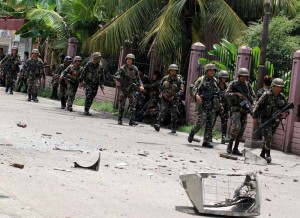Schools, shops and other establishments in the city were closed, and flights to and from Zamboanga City were cancelled.
“The rebels fired several rocket propelled grenades on civilian areas and two hit a school in downtown area and it’s just lucky that no people were killed in the random attacks,” one policeman said, adding gunmen took positions in civilian houses and made it difficult for security forces to launch an assault.
One rocket hit the regional office of the National Statistics Office, but no casualties were reported.
“I saw the rebels take positions on the side of the road just several blocks away from the regional hospital and they fired a rocket on the soldiers, but missed them,” one security guard said.
One woman said she saw young rebels firing automatic weapons at the soldiers who were securing the hospital.
“There were all young fighters, probably 16 or17 years old and I was so scared,” she said.
One uniformed MNLF fighter, who was positioned near Santa Barbara village, told local radio network Radyo Agong his group came from Sulu province and were led by Haber Malik, a lieutenant of Misuari. He said they were fighting for independence.
Misuari ran for governor in the Autonomous Region in Muslim Mindanao (ARMM) in May but lost. He also ran thrice as governor in Sulu in previous years but was repeatedly defeated.
MNLF legal counsel and spokesman Emmanuel Fontanilla said the MNLF elements that raided Zamboanga was part of the advance party of Misuari who will be visiting the city.
Misuari, Fontanilla said, planned to go around Mindanao to consult the people on his declaration of independence, without resorting to violence.
The spokesman called on a third party like the Organization of Islamic Countries or the United Nations to intervene and prevent more bloodshed.
Fontanilla warned that unless the problem was addressed immediately it might spread to other cities and towns in Mindanao.
“It would be prudent for the OIC to intervene on this matter as it might escalate,” he said.
“We are not threatening but it could be worse than 1972. This will be more than that,” Fontanilla added, alluding to the bloody war waged by the MNLF against the government of President Ferdinand Marcos.
He also said the explanatory note of the government in relation to the peace process with the Moro Islamic Liberation Front (MILF) has deeply hurt the MNLF since it was made to appear that Misuari was no longer the legitimate representative of the Bangsamoro people.
In 2001, MNLF forces loyal to Misuari launched an attack in Zamboanga and the fighting left over 100 people dead.
On Monday, MNLF snipers were shooting at police and military targets.
Mayor Maria Isabelle Salazar suspended all classes in the city. She also said gunmen were holding at least 220 people in the villages.
But the Philippine National Police (PNP) denied the MNLF was holding 200 civilian hostages.
“There are 200 people stranded in Barangay Santa Calina . . . they cannot leave, but they are not hostages,” PNP spokesman Senior Supt. Wilben Mayor told a press briefing in Camp Crame.
Salazar asked citizens to stay calm and stay inside their houses until the situation returned to normal.
More than 90 percent of commercial establishments in Zamboanga City were shuttered throughout the day.
Reports indicated that more than 300 MNLF fighters occupied several villages.
The PNP national operations center in Camp Crame said the MNLF rebels swooped down on the villages of Rio Hondo, Santa Barbara, Santa Catalina and Mariki.
The MNLF fighters also declared Misuari as “president,” reports said.
Fontanilla said in a radio interview MNLF forces controlled seven villages in Zamboanga City.
Lt. Col. Ramon Zagala, Armed Forces of the Philippines (AFP) spokesman, said the lone soldier who was killed belonged to the Naval Special Operations Group that tried to hold off MNLF fighters who were advancing on Rio Hondo.
Zagala said the military received intelligence information three days ago that MNLF forces were planning a mass rally in Zamboanga similar to the one they held in Davao last month, but it was only last night that they learned that the group planned to storm Zamboanga City.
Zagala said troops were sent to the city proper to foil MNLF plans to attack the city hall.
He said about 20 MNLF fighters herded 20 people at the Caitangyan area in the coastal barangay of Sta. Catalina, about one to two kilometers from the city hall.
Zagala said the MNLF might be planning to use the civilians as human shields.
Defense Secretary Voltaire Gazmin and Interior Secretary Mar Roxas flew to Zamboanga City for a firsthand look at the situation.
In Malacañang, Palace spokesman Edwin Lacierda condemned “in the strongest possible terms” the MNLF attack on Zamboanga City.
“It is incumbent on all people of goodwill to reject the violence that has erupted,” Lacierda said.
He said the authorities were dealing with the situation ”in a manner that will reduce the risk to innocent civilians and restore peace and order to Zamboanga City at the soonest possible time.”
The President met with the Security Cluster and was briefed by military and police officials on the Zamboanga situation, Lacierda said.
The Civil Aviation Authority of the Philippines (CAAP) suspended on Monday all commercial flights in and out of the Zamboanga International Airport.
CAAP said 10 flights were cancelled and the rest of the flights to and from Zamboanga had been put on hold.
The cancelled flights include the PAL Express 2P-997/2P-998 (Manila-Zamboanga-Manila) and scheduled flights from Zamboanga to Jolo, Davao, and Cebu.
Eight flights from Cebu Pacific Air (CEB) have been cancelled: 5J-840 (Tawi-Tawi-Zamboanga), 5J-434 (Zamboanga-Cebu), 5J-857/5J-858 (Mnaila-Zamboanga-Manila, 5J-855/5J-856 (Manila-Zamboanga-Manila), and 5J-393/5J-394 (Davao-Zamboanga-Davao).
PAL said passengers booked on cancelled flights may arrange for a rebooking or refund with any PAL or PAL Express ticket office. Cebu Pacific advised its affected passengers to rebook their flights within 30 days, or opt for a full refund.


